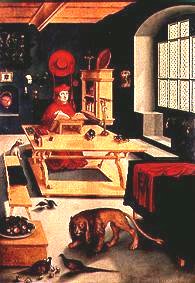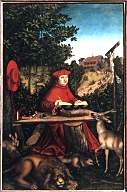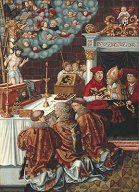Points to Ponder, Late Gothic &
Renaissance Art in N. Europe Gallery
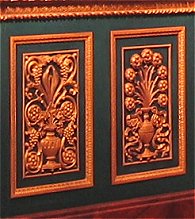 |
|
Wainscot panels
Phillips, the Art Museum's architect, installed these originally blue and gold wainscot panels in Gallery 3, which was
installed as the Italian Renaissance gallery.
These gilt wood panels were acquired from the Stanford
White estate. The historic wainscot panels were originally cabinet doors in the library of
the historic Villa Palmieri near Florence on one of the many occasions
when the building was remodeled. Its most famous tenant, Boccaccio wrote his Decamerone
there.
The blue color of the panels was changed to turquoise when
the room was reinstalled as a North European Renaissance art gallery.
Some think that the wainscoting might have been OK for an
Italian renaissance room, but is too gaudy and dominant for this more delicate North
European gallery, and takes away from the beautiful paintings, displayed here.
|
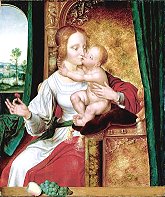
|
|
Madonna of the Cherries Quentin
Masseys made for 4 copies of this painting. We don't know who has the original. All copies
hang in well-known museums.
|
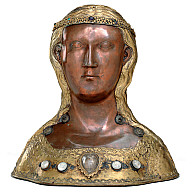
|
|
Head Reliquary 15th century Mitchel Merling.
Curator, mentioned in a walk-through in December 2000:
It is copper-gilt. It dates probably from the 14th century.
The semi-precious stones were added much later. |
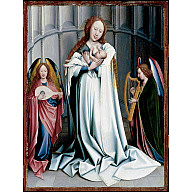
|
|
Virgin and Child in an Apse c. 1539
Artist: Follower of Robert Campin, who was also called the Master of
Flemalle
(Campin was Flemish, c. 1375/79-1444, active in Tournai)Docent class 1/25/2000:
This is a copy painted in ca. 1535. There were over a hundred copies
painted at that time. The original was painted in 1425 by the Master of Flemalle (town in
Southern Belgium), who is now believed to be Robert Campin.
The original painting does not exist anymore. |
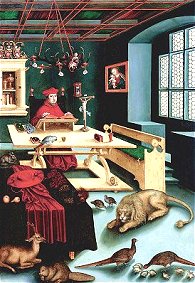 |
|
|
Although internal literature mentions that Lucas
Cranach (the Elder) disliked Cardinal Albrecht, it seems that
Cranach painted several paintings of him.
Above, on the left is from the Ringling Museum, the second painting is
very similar and is in the Hessisches Landesmuseum, Darmstadt, Germany.
In the 2 paintings on the right he is called Archbishop of Mainz. It is
exactly the same pose as in the other paintings, but now he is still an archbishop
(Museum: Stiftung Preussischer Kulturbesitz, Gem ldegalerie, Berlin, 1527).
Protestantism:
Suppose that if there was a new law today that e.g. Creationism was now the accepted law,
would you object and change religion and place of worship? Of course you wouldn't.
Do you think that the people in Northern Europe in the mid 1500s were any different? Nah,
their main concerns were the health of their family and having a full belly.
There were new church taxes imposed for this new cathedral in Rome being built (now the
famous St Peter's church), plus the 10% tax dictated by Phillips II to pay for his war
against France. The poor peasant in Northern Europe were starving and they rebelled. They
protested, and the protesters became the protestants. Nothing to do with
religion. Just with survival.
Many noblemen in the Netherlands (and Northern Germany) became protestants, just to spite
Phillips II. It grew from there.
Other:
Send me more Points to Ponder with source to share here.
ringlingdocents.org
|





